Fittings For Drip Irrigation Systems
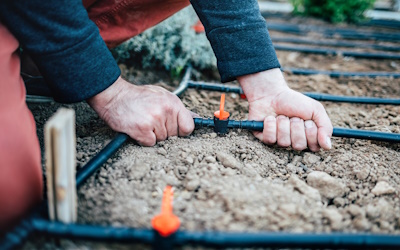
Figure 1: Fittings used in a drip irrigation system
Fittings for drip irrigation systems are essential to ensure a smooth, cost-effective, and water-efficient way to water plants. Common drip irrigation fittings are compression fittings, barbed fittings, couplings, and end caps. This article delves into the different types of fittings available for drip irrigation systems, their specific functions, and the factors to consider when selecting the appropriate fittings for an irrigation system.
Table of contents
- Drip irrigation system fittings
- Fitting comparison
- Drip irrigation fitting sizes
- How to remove broken drip irrigation fittings
- FAQs
View our online selection of fittings and clamps!
Drip irrigation system fittings
A drip irrigation system delivers water directly to the root zone of plants. This irrigation method uses less water than traditional sprinkler irrigation systems and can help reduce water runoff and evaporation. Fittings are essential for drip irrigation systems. They connect different system components, allow for changes in the flow direction, and prevent leaks by providing a secure connection.
Compression fittings
- Key features: Water-tight seal, suitable for high-pressure applications
- Size:Compression fittings for drip irrigation systems are designed to match a specific single outside diameter measurement of tubing; they are not intended to accommodate a range of sizes like barbed fittings. They go around the outside of the tubing, which makes them bigger than barbed fittings.
- Insertion process: Move the compression nut over the tube, followed by the compression ring. Push the tube into the fitting until fully inserted to the required depth. While securing the fitting's body or socket with an adjustable wrench, securely fasten the compression nut to the body to ensure a tight connection.
- Sealing tightness: Compression fittings make a tight and lasting seal when put on correctly.
- Application areas: Compression fittings are typically used for connecting mainlines and sub-mains to laterals and emitters (devices that deliver water to the plants). They are also well-suited for use in areas with high water pressure, making them a reliable option for large-scale drip irrigation systems.
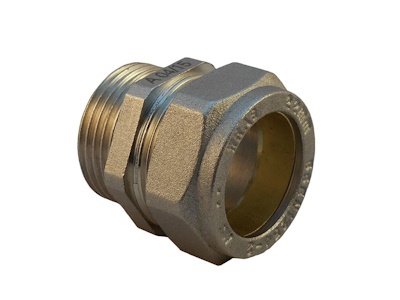
Figure 2: Compression fitting
Barbed fittings
- Key features: Affordable, simple to insert, compact
- Size:Barbed fittings match the inside diameter of the tubing and can accommodate various sizes, unlike compression fittings. They are smaller than compression fittings as they fit inside the tubing.
- Insertion process: To install a barb fitting, push the barbed end into the end of a tube. Then select a clamp that fits well, like a hose clamp, and tighten it down. This creates a strong seal. However, the clamp can slightly change the shape of the tubing. This usually isn't a problem unless the tube is to be reused.
- Note: Pushing a barbed fitting into cold tubing can be difficult, so dip the tubing end in warm water for ten seconds before pushing in a barbed fitting. This makes the insertion easy.
- Sealing tightness: Using barbed fittings alone may not ensure a tight connection. To make the connection watertight, secure them with insertion tools like clamps.
- Application areas: Barbed fittings are a good choice for smaller irrigation systems, like DIY irrigation projects. They are typically used for connecting laterals and emitters in low-pressure applications.

Figure 3: A hose barb fitting secured with a clamp
Drip irrigation barbed fitting leaking
Barbed fittings can leak if not properly installed. To fix a leaky drip irrigation barbed fitting:
- Ensure the fitting is properly seated.
- Check for debris and remove it.
- Tighten the hose clamp.
- Replace the fitting if necessary.
- Use a sealant as a last resort.
Couplings, tees, and elbows
Both barbed and compression fittings can come in the form of couplings, tees, and elbows, adapting to the specific needs of a piping system.
- Couplings connect two pipes of the same size end-to-end. It's used to extend the length of a pipe or repair a broken section.
- A tee (Figure 4) is a T-shaped fitting with three openings used to connect three pipe sections. It is used to create a branch line from a main line.
- Elbows (Figure 5) are used when the pipe needs to turn at a certain point within the system, such as around a corner or through an obstruction. They are available in various angles, like 90 degrees, 45 degrees, and 22.5 degrees.
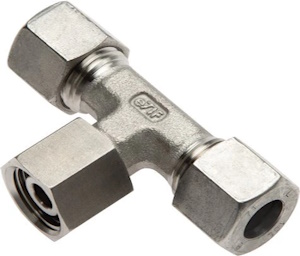
Figure 4: Tee compression fitting
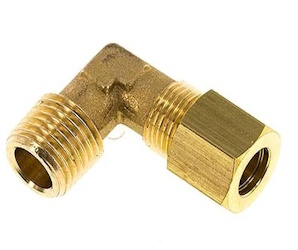
Figure 5: Elbow compression fitting
End cap
An end cap is a fitting to seal the end of a pipe or tube. It is typically made of plastic, metal, or rubber and can be attached to the end of the pipe using glue, threading, or crimping. An end cap fitting in a drip irrigation system serves to:
- Seal the end of the irrigation line, preventing water from leaking out.
- Maintain water pressure within the system for even water distribution.
- Allow for easy flushing of the line to remove debris and prevent clogging.
When choosing an end cap, it is important to consider the material of the pipe or tube, the size of the pipe or tube, and the application. It is also important to ensure the end cap is compatible with the type of pipe or tube.
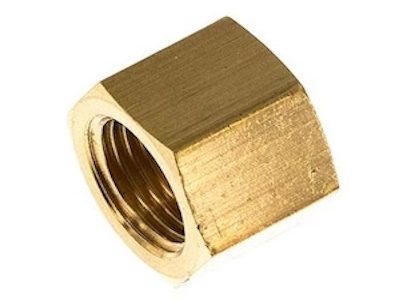
Figure 5: Brass end cap
Fitting comparison
Table 1: Compression and barbed fittings comparison
| Fitting name | Advantages | Disadvantages |
| Compression fittings | Leakproof secure connection, reusable | It can be more expensive and larger than barbed fittings and may require more labor time to install |
| Barbed fittings | Inexpensive, easy to install, Compact | Not as secure as compression fittings, may leak if not properly installed |
Drip irrigation fitting sizes
Drip irrigation systems typically use standard fitting sizes to ensure compatibility between components such as tubes, hoses, emitters, connectors, and end caps. The most common sizes for drip irrigation tubing are 1/2 inch, 5/8 inch, and 1/4 inch in diameter, with 1/2 inch being the most widely used for main lines. The 1/4 inch size is often used for micro-tubing that serves as a feeder line from the main tubing to individual plants. Fittings, including end caps, tees, elbows, and connectors, are designed to match these standard tubing sizes for a snug and secure fit. Read our irrigation system fittings article for more details on the common fittings used in irrigation systems, their roles, and how they contribute to water management within these systems.
How to remove broken drip irrigation fittings
There are a few steps to fix a broken drip irrigation fitting. First, identify the location of the leak. This can be done by following the drip line and spot where water is spraying out. Once the leak has been located, perform the following steps:
- Turn off the water supply to prevent leaks and water waste.
- Carefully cut the tubing close to the fitting with a tubing cutter or sharp scissors.
- If the fitting is stuck inside the tubing, use needle-nose pliers to grip and gently wiggle the fitting out.
- If the leak is small, repair it with tape. Wrap the tape around the leak until it is completely covered. If the leak is large, apply cement and let it dry completely. Replace the fitting if it is broken beyond repair. To do this, cut out the damaged fitting and replace it with a new one.
FAQs
How to install drip irrigation compression fittings?
Cut the tubing cleanly, slide the nut onto the tubing, insert the tubing into the fitting, then tighten the nut for a secure seal.
Can PVC fittings be used for drip irrigation?
PVC fittings can be used in drip irrigation systems for low-pressure applications.
What are the benefits of using drip irrigation threaded fittings?
Drip irrigation threaded fittings provide several advantages, including ease of installation, durability, and resistance to high water pressure.











